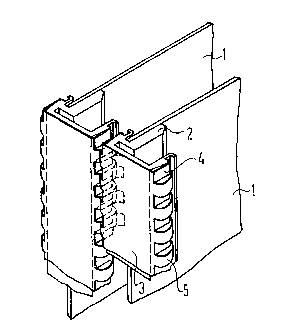Some of the information on this Web page has been provided by external sources. The Government of Canada is not responsible for the accuracy, reliability or currency of the information supplied by external sources. Users wishing to rely upon this information should consult directly with the source of the information. Content provided by external sources is not subject to official languages, privacy and accessibility requirements.
Any discrepancies in the text and image of the Claims and Abstract are due to differing posting times. Text of the Claims and Abstract are posted:
| (12) Patent Application: | (11) CA 2018457 |
|---|---|
| (54) English Title: | SHIELDING APPARATUS FOR AN ELECTRICAL ASSEMBLY |
| (54) French Title: | DISPOSITIF DE BLINDAGE POUR SYSTEMES ELECTRIQUES |
| Status: | Deemed Abandoned and Beyond the Period of Reinstatement - Pending Response to Notice of Disregarded Communication |
| (51) International Patent Classification (IPC): |
|
|---|---|
| (72) Inventors : |
|
| (73) Owners : |
|
| (71) Applicants : |
|
| (74) Agent: | SMART & BIGGAR LP |
| (74) Associate agent: | |
| (45) Issued: | |
| (22) Filed Date: | 1990-06-07 |
| (41) Open to Public Inspection: | 1990-12-09 |
| Availability of licence: | N/A |
| Dedicated to the Public: | N/A |
| (25) Language of filing: | English |
| Patent Cooperation Treaty (PCT): | No |
|---|
| (30) Application Priority Data: | ||||||
|---|---|---|---|---|---|---|
|
ABSTRACT OF THE DISCLOSURE
Shielding apparatus for an electrical assembly. A
shroud that covers a front cover of the assembly is
located at the front side of the electrical assembly that
is insertable into a magazine. The shroud is snapped
onto the front cover with retaining tabs and has
laterally resilient contact tabs that are contacted by
contact tabs of neighboring shrouds. As a result, the
shrouds are directly connected to one another, so that
only one electrical function between the shielding parts
is established per assembly. In particular, the
shielding effect is so effective that the shrouds can be
utilized in radio-frequency electrical systems.
Note: Claims are shown in the official language in which they were submitted.
Note: Descriptions are shown in the official language in which they were submitted.

2024-08-01:As part of the Next Generation Patents (NGP) transition, the Canadian Patents Database (CPD) now contains a more detailed Event History, which replicates the Event Log of our new back-office solution.
Please note that "Inactive:" events refers to events no longer in use in our new back-office solution.
For a clearer understanding of the status of the application/patent presented on this page, the site Disclaimer , as well as the definitions for Patent , Event History , Maintenance Fee and Payment History should be consulted.
| Description | Date |
|---|---|
| Inactive: IPC from MCD | 2006-03-11 |
| Time Limit for Reversal Expired | 1998-06-08 |
| Application Not Reinstated by Deadline | 1998-06-08 |
| Inactive: Abandon-RFE+Late fee unpaid-Correspondence sent | 1997-06-09 |
| Deemed Abandoned - Failure to Respond to Maintenance Fee Notice | 1997-06-09 |
| Application Published (Open to Public Inspection) | 1990-12-09 |
| Abandonment Date | Reason | Reinstatement Date |
|---|---|---|
| 1997-06-09 |
Note: Records showing the ownership history in alphabetical order.
| Current Owners on Record |
|---|
| SIEMENS AKTIENGESELLSCHAFT |
| Past Owners on Record |
|---|
| EDUARD MAIR |
| INGEBORG BUSSE |
| PETER SEDLMEIER |